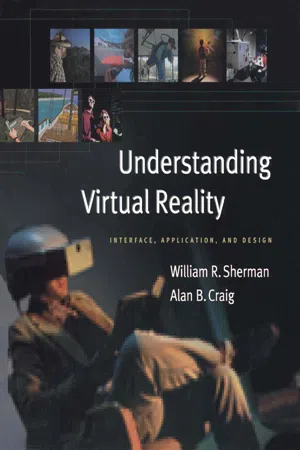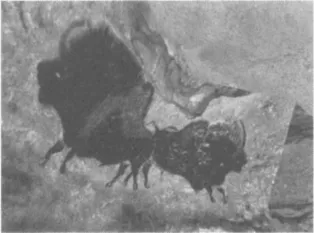![]()
PART I
WHAT IS VIRTUAL REALITY?
![]()
Introduction to What Is Virtual Reality?
Chapter 1 begins with our description of what is meant by virtual reality (VR). We begin with the dictionary definitions of virtual and reality and consider how these individual words combine to describe a unique means of human communication. We go on to define other key terms and offer a brief history of the origins of VR.
Chapter 2 examines how knowledge about previously existing media can be applied to the medium of virtual reality and looks at the media from which VR has evolved. We compare the characteristics of virtual reality with other media for human communication and explore how VR is used to convey models of virtual worlds.
![]()
CHAPTER 1
Introduction to Virtual Reality
Human history is marked by a progression of media used to convey and experience ideas. Perhaps the most recent step in this progression is the use of virtual reality. Recorded history begins with people painting on cave walls to express the happenings of the hunt and sharing stories to chronicle the history of a community or tribe. It was the importance of communication that raised the storyteller to a position of high esteem in the community.
The first cave paintings transcend the physical experience they depict (FIGURE 1-1). These paintings were a primitive medium for conveying the artist’s concept. They were a method for communicating ideas, useful facts, and events among people. Viewers then superimposed their own interpretations on the painter’s manifested expression.
FIGURE 1-1 Cave paintings were an early medium for storytelling. A virtual world could be conveyed from one person to another via the technology of pigment on stone. (Image courtesy of Benjamin Britton)
Starting with the first pigment spread on cave walls, new technologies have developed and evolved, leading in turn to new media (FIGURE 1-2). Along the way, humans have explored ways to utilize each new medium to best express their ideas. Virtual reality is a new medium brought about by technological advances in which much experimentation is now taking place to find practical applications and more effective ways to communicate.
FIGURE 1-2 From painting cave walls to sharing computer-generated images on the screens of a virtual CAVE and beyond, the history of humankind has been marked with a progression of new media.
Defining Virtual Reality
Because virtual reality is a new medium, its definition is still in flux. The researchers and users of VR naturally have their own points of view. Those less familiar with the field may have slightly different interpretations. The definition we use in this book reflects what is generally meant by practitioners and scholars of the field of VR—which is not always how the term is used by marketing departments and the mass media.
Webster’s New Universal Unabridged Dictionary [1989] defines virtual as “being in essence or effect, but not in fact.” This usage has been applied to earlier concepts in computing; for example, when a computer system requires more RAM (primary storage) than is available, memory is expanded virtually by use of disk storage (secondary, cheaper storage). The resultant, seemingly enlarged RAM capacity is referred to as virtual memory.
What is meant by reality is more complicated, and trying to define it completely can result in complex philosophical discussions. Webster’s defines reality as “the state or quality of being real. Something that exists independently of ideas concerning it. Something that constitutes a real or actual thing as distinguished from something that is merely apparent.” To simplify things for our purposes, let’s say it is a place that exists and that we can experience.
Four Key Elements of Virtual Reality Experience
The key elements in experiencing virtual reality—or any reality for that matter—are a virtual world, immersion, sensory feedback (responding to user input), and interactivity.
Key Element 1: Virtual World
A virtual world is the content of a given medium. It may exist solely in the mind of its originator or be broadcast in such a way that it can be shared with others. A virtual world can exist without being displayed in a virtual reality system (i.e., an integrated collection of hardware, software, and content assembled for producing virtual reality experiences)–much like play or film scripts exist independently of specific instances of their performance. Such scripts do in fact describe virtual worlds. Let’s carry the analogy further. We can refer to the script of a play as merely the description of a play. When that description is brought to life via actors, stage sets, and music, we are experiencing the play’s virtual world. Similarly, a computer-based virtual world is the description of objects within a simulation. When we view that world via a system that brings those objects and interactions to us in a physically immersive, interactive presentation, we are experiencing it via virtual reality.
virtual world 1. an imaginary space often manifested through a medium. 2. a description of a collection of objects in a space and the rules and relationships governing those objects.
Key Element 2: Immersion
Considering the user must be immersed within some other, alternate reality, an admittedly simplistic definition of VR might be
Immersion into an alternate reality or point of view.
But what does this mean? Where do you go to get immersed into an alternate reality or point of view? What in fact is an alternate reality or point of view? According to our simple definition, a medium qualifies if its participants are able to perceive something other than they would have without an external influence. This definition acknowledges the possibility of perceiving something besides the world you are currently living in in two ways: you can either perceive an alternate world or the normal world from another point of view.
An alternate world might be a representation of an actual space that exists elsewhere, or it could be a purely imaginary environment. Alternate worlds are often created in the minds of novelists, composers, and other artists and creative individuals.
Imagine for a moment that you are empowered with the magical ability to live in a world other than the one you currently inhabit. ...


